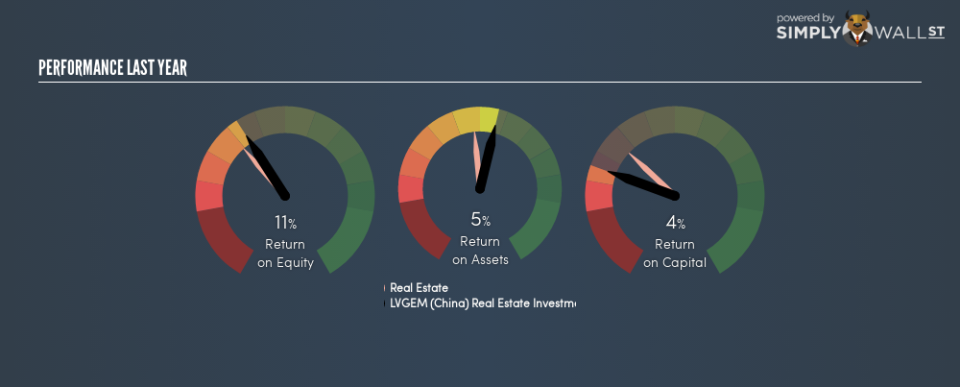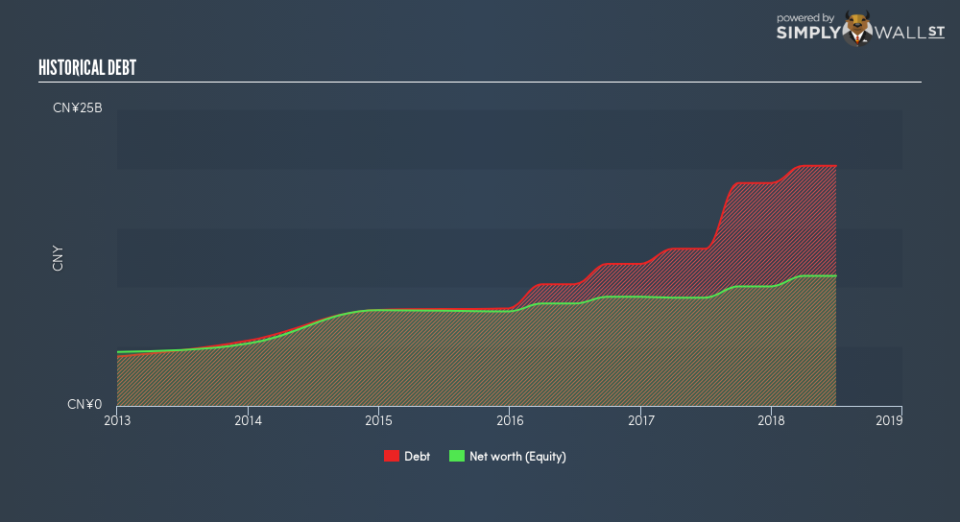What You Must Know About LVGEM (China) Real Estate Investment Company Limited’s (HKG:95) ROE

The content of this article will benefit those of you who are starting to educate yourself about investing in the stock market and want to learn about Return on Equity using a real-life example.
LVGEM (China) Real Estate Investment Company Limited (HKG:95) delivered an ROE of 10.8% over the past 12 months, which is an impressive feat relative to its industry average of 9.3% during the same period. On the surface, this looks fantastic since we know that 95 has made large profits from little equity capital; however, ROE doesn’t tell us if management have borrowed heavily to make this happen. Today, we’ll take a closer look at some factors like financial leverage to see how sustainable 95’s ROE is.
See our latest analysis for LVGEM (China) Real Estate Investment
Breaking down ROE — the mother of all ratios
Return on Equity (ROE) is a measure of LVGEM (China) Real Estate Investment’s profit relative to its shareholders’ equity. An ROE of 10.8% implies HK$0.11 returned on every HK$1 invested. In most cases, a higher ROE is preferred; however, there are many other factors we must consider prior to making any investment decisions.
Return on Equity = Net Profit ÷ Shareholders Equity
ROE is assessed against cost of equity, which is measured using the Capital Asset Pricing Model (CAPM) – but let’s not dive into the details of that today. For now, let’s just look at the cost of equity number for LVGEM (China) Real Estate Investment, which is 14.8%. Since LVGEM (China) Real Estate Investment’s return does not cover its cost, with a difference of -4.0%, this means its current use of equity is not efficient and not sustainable. Very simply, LVGEM (China) Real Estate Investment pays more for its capital than what it generates in return. ROE can be split up into three useful ratios: net profit margin, asset turnover, and financial leverage. This is called the Dupont Formula:
Dupont Formula
ROE = profit margin × asset turnover × financial leverage
ROE = (annual net profit ÷ sales) × (sales ÷ assets) × (assets ÷ shareholders’ equity)
ROE = annual net profit ÷ shareholders’ equity
The first component is profit margin, which measures how much of sales is retained after the company pays for all its expenses. Asset turnover reveals how much revenue can be generated from LVGEM (China) Real Estate Investment’s asset base. And finally, financial leverage is simply how much of assets are funded by equity, which exhibits how sustainable the company’s capital structure is. Since ROE can be inflated by excessive debt, we need to examine LVGEM (China) Real Estate Investment’s debt-to-equity level. The debt-to-equity ratio currently stands at a high 185%, meaning the above-average ratio is a result of a large amount of debt.
Next Steps:
ROE is one of many ratios which meaningfully dissects financial statements, which illustrates the quality of a company. LVGEM (China) Real Estate Investment exhibits a strong ROE against its peers, however it was not high enough to cover its own cost of equity this year. Its debt level is above equity which means its above-industry ROE may be driven by debt funding which raises concerns over the sustainability of LVGEM (China) Real Estate Investment’s returns. Although ROE can be a useful metric, it is only a small part of diligent research.
For LVGEM (China) Real Estate Investment, there are three relevant aspects you should further examine:
Financial Health: Does it have a healthy balance sheet? Take a look at our free balance sheet analysis with six simple checks on key factors like leverage and risk.
Valuation: What is LVGEM (China) Real Estate Investment worth today? Is the stock undervalued, even when its growth outlook is factored into its intrinsic value? The intrinsic value infographic in our free research report helps visualize whether LVGEM (China) Real Estate Investment is currently mispriced by the market.
Other High-Growth Alternatives : Are there other high-growth stocks you could be holding instead of LVGEM (China) Real Estate Investment? Explore our interactive list of stocks with large growth potential to get an idea of what else is out there you may be missing!
To help readers see past the short term volatility of the financial market, we aim to bring you a long-term focused research analysis purely driven by fundamental data. Note that our analysis does not factor in the latest price-sensitive company announcements.
The author is an independent contributor and at the time of publication had no position in the stocks mentioned. For errors that warrant correction please contact the editor at editorial-team@simplywallst.com.

 Yahoo Finance
Yahoo Finance 

